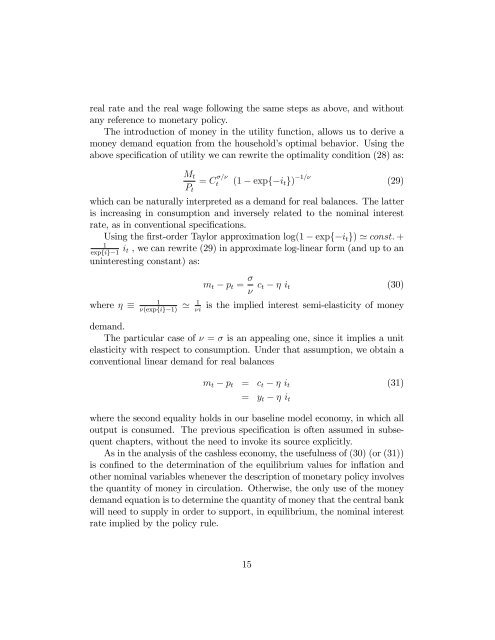Monetary Policy, Inflation, and the Business Cycle Chapter 2 A ...
Monetary Policy, Inflation, and the Business Cycle Chapter 2 A ...
Monetary Policy, Inflation, and the Business Cycle Chapter 2 A ...
You also want an ePaper? Increase the reach of your titles
YUMPU automatically turns print PDFs into web optimized ePapers that Google loves.
eal rate <strong>and</strong> <strong>the</strong> real wage following <strong>the</strong> same steps as above, <strong>and</strong> without<br />
any reference to monetary policy.<br />
The introduction of money in <strong>the</strong> utility function, allows us to derive a<br />
money dem<strong>and</strong> equation from <strong>the</strong> household’s optimal behavior. Using <strong>the</strong><br />
above speci…cation of utility we can rewrite <strong>the</strong> optimality condition (28) as:<br />
M t<br />
P t<br />
= C =<br />
t (1 expf i t g) 1= (29)<br />
which can be naturally interpreted as a dem<strong>and</strong> for real balances. The latter<br />
is increasing in consumption <strong>and</strong> inversely related to <strong>the</strong> nominal interest<br />
rate, as in conventional speci…cations.<br />
Using <strong>the</strong> …rst-order Taylor approximation log(1 expf i t g) ' const: +<br />
1<br />
i expfig 1 t , we can rewrite (29) in approximate log-linear form (<strong>and</strong> up to an<br />
uninteresting constant) as:<br />
m t p t = c t i t (30)<br />
where <br />
1<br />
(expfig 1) ' 1 i<br />
is <strong>the</strong> implied interest semi-elasticity of money<br />
dem<strong>and</strong>.<br />
The particular case of = is an appealing one, since it implies a unit<br />
elasticity with respect to consumption. Under that assumption, we obtain a<br />
conventional linear dem<strong>and</strong> for real balances<br />
m t p t = c t i t (31)<br />
= y t i t<br />
where <strong>the</strong> second equality holds in our baseline model economy, in which all<br />
output is consumed. The previous speci…cation is often assumed in subsequent<br />
chapters, without <strong>the</strong> need to invoke its source explicitly.<br />
As in <strong>the</strong> analysis of <strong>the</strong> cashless economy, <strong>the</strong> usefulness of (30) (or (31))<br />
is con…ned to <strong>the</strong> determination of <strong>the</strong> equilibrium values for in‡ation <strong>and</strong><br />
o<strong>the</strong>r nominal variables whenever <strong>the</strong> description of monetary policy involves<br />
<strong>the</strong> quantity of money in circulation. O<strong>the</strong>rwise, <strong>the</strong> only use of <strong>the</strong> money<br />
dem<strong>and</strong> equation is to determine <strong>the</strong> quantity of money that <strong>the</strong> central bank<br />
will need to supply in order to support, in equilibrium, <strong>the</strong> nominal interest<br />
rate implied by <strong>the</strong> policy rule.<br />
15
















